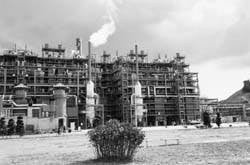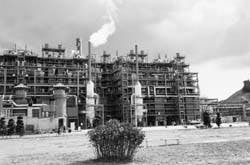Petrochemical Report World ethylene capacity increased margnally in 1995
About this report...
Although ethylene capacity increased little the past year, the industry is perched on the edge of a construction boom. U.S. producers have announced plans to build 5.9 million mty of capacity by the year 2000, while proposals in Thailand call for as much as 2.8 million mty. On the demand side, China's booming economy is supporting a capacity increase of 1.7 million mty over the period.The Journal's annual Petrochemical Report, written and analyzed by Petrochemical Editor Anne K. Rhodes, also reveals that planned expansion of the polyolefins industry will cause loose markets until 1997/1998, when operating rates will begin to improve.
A technological overview of a VCM plant revamp shows how a producer in the Ukraine plans to increase capacity and reduce emissions.
Hanwha Chemical Corp. (formerly Han Yang Chemical Corp.) started up this 400,000 metric ton/year (mty) ethylene plant in Yeochun, South Korea, in December 1992. The addition of this plant has increased South Korea's ethylene production capacity to 3.625 mty, making it second only to Japan in the Asia/Pacific region.
World ethylene capacity is 79.3 million metric tons/year (mty), according to the Journal's most recent survey of ethylene producers. This is an increase of 1.2 million mty, or 1.6%, since the 1995 survey (OGJ, Apr. 17, 1995, p. 33).
The only major changes over the past year are:
- Start-up of a 320,000 mty ethylene plant by Ethylene Malaysia Sdn. Bhd. at Kerteh, Malaysia
- Expansion by Neftechim's plant at Burgas, Bulgaria, to 250,000 mty from 35,000 mty
In addition to these changes, three errors in previous surveys have been corrected:
- LG Chemical Ltd.'s 450,000 mty plant in South Korea started up in 1991, but was not listed in previous surveys.
- The capacity of the Elf/BP ethylene unit at Lavera, France, previously reported as 365,000 mty, is now known to be 700,000 mty.
- Petroquimica Uniao SA's 400,000 mty plant at Santo Andre, Brazil, was listed twice in last year's survey.
The growth figures quoted previously are based on corrected 1995 figures.
Table 1 [12785 bytes] shows regional ethylene capacities. North America has 34% of world capacity, Western Europe 24%, and the Asia/Pacific region 22%.
Table 2 [33059 bytes] lists national ethylene capacities. The only countries showing appreciable increases since last year are Bulgaria, France, and Malaysia, for reasons stated previously.
Capacity expansion
The ethylene industry is in the midst of a capacity boom. Gary Adams, Chemical Market Associates Inc. (CMAI), Houston, predicts global capacity will increase from 75 million mty in 1994 to 101 million mty in 2000.
This projected 26 million mty addition shakes out as:
- 12.1 million mty in the Asia/Pacific region
- 7.4 million mty in North America
- 3.1 million mty in the Middle East and Africa
- 1.6 million mty in Eastern Europe/C.I.S.
- 1.2 million mty in Western Europe
- 1.0 million mty in Latin America.
Adams says these additions will result in an annual growth rate of 5.1% for the next 4 years, compared to demand growth of 4.9%/year. The difference between these two rates will result in capacity that exceeds demand by 13.8 million mty in 2000, and operating rates of only 86%, says Adams.
Marshall Frank, president of Chem Systems Inc., Tarrytown, N.Y., paints a similar picture of ethylene capacity growth. Frank predicts world ethylene capacity to reach 103.6 million mty by 2000, with East Asia's share of world capacity increasing from 12.1% in 1995 to 17.8% in 2000 (East Asia excludes Japan).
The two areas expected to comprise most of the capacity increase for the remainder of the decade are Asia/Pacific and North America, excluding Mexico.
Table 3 [14730 bytes] shows regional capacity increases projected by Samuel Weinberger, ethylene planning manager for Exxon Chemical Co., Houston. In a paper presented at Chem Systems' annual U.S. petrochemical conference, Jan. 29-Feb. 1, Houston, Weinberger said growth in China was expected to be 12.5%/year.
Howard Blum, director of Chem Systems Japan Ltd., Tokyo, outlined China's expansion plans at the meeting (Table 4 [35590 bytes]). Over the 5-year period, China's ethylene producers are expected to add almost 1.7 million mty of capacity, says Blum.
Thailand's plans include (OGJ, Apr. 3, 1995, p. 23):
- A 500,000 mty cracker under construction by Thai Petrochemical Industry, scheduled for start-up in 1997
- A 600,000 mty cracker to be built by Thai Polyethylene Co., scheduled for 1999 start-up
- An 800,000 mty plant planned by Siam Cement Group, scheduled for 1999 start-up
- A 400,000 mty cracker to be built by Bangkok Polyethylene Co., also due on stream in 1999
- A 500,000 mty cracker to be built by National Petrochemical plc, scheduled for start-up in 2000.
Table 5 [37727 bytes] shows planned additions to U.S. ethylene capacity, according to Earl Armstrong, group vice-president of DeWitt & Co. Inc., Houston. Of the 5.9 million mty in announced additions, Armstrong considers almost 2.8 million mty to have a high probability of taking shape.
Latin America is another area to watch, says Robert Bauman, vice-president of polymers for Chem Systems Inc.
Mexico's privatization efforts are attracting much foreign interest (OGJ, Nov. 6, 1995, p. 16). And post-privatization opportunities may exist in Argentina and Brazil, says Bauman.
Table 6 [30501 bytes] shows Chem Systems' projections for additions to Latin American ethylene capacity between 1995 and 2000.
Profitability
Ethylene supply and demand patterns are commonly known to be the bellwether of petrochemical industry profitability. Fig. 1 [44218 bytes] shows Chem Systems Inc.'s ethylene market outlook.
A number of announced capacity additions after 1997 are considered speculative by Chem Systems. If none of these projects materialize, the global ethylene utilization rate could reach 96% by 2000 and essentially 100% by 2001, according to Frank, who considers this an unlikely scenario.
Considering only U.S. expansions that are either under way or considered certain, U.S. operating rates will decrease from 97% in 1994 to less than 90% by 2000 predicts Frank. This indicates significant erosion of ethylene margins over the next several years.
"The downturn in profitability has already begun," says Frank. Chem Systems predicts, however, that the current downturn will limit capacity additions beyond those already under way. As a result, says Frank, by 2000, demand will catch up with supply and operating rates and profitability will begin to increase again (Fig. 2 [33337 bytes]).
David Glass, director of Chem Systems Ltd., London, says the profitability of Western European petrochemical producers was virtually halved during a 6-month period in 1995 (Fig. 3 [26771 bytes]). Glass expects profitability to stabilize at current levels, however, prompting a recovery of prices.
"The bigger concern is for 1997 and beyond," says Glass, "as...capacity increases and economic conditions lead to a check to demand and lower operating rates. Europe may be in a better position than other regions to sustain [high operating rates]," says Glass, "but global capacity increases may override this caution on new investment."
For the U.S. picture, CMAI's Adams predicts: "Relatively high operating rates in 1997...will generate a significant rebound in prices" (Fig. 4 [51363 bytes]).
"Beginning in 1998, however," says Adams, "merchant sellers of ethylene in the U.S. will suffer from one of the more significant periods of oversupply...experienced in the last two decades. Cash margins will fall to the point that a new olefins plant with high depreciation expense will not completely cover total costs."
Adams predicts that the U.S. industry will return to a profitable period soon after the turn of the century.
Feedstock usage
Few expect the mix of ethylene feedstocks to change appreciably for the foreseeable future. Fig. 5 [34976 bytes] shows Chem Systems' predictions for global feedstock usage in 2000, compared to 1992.
Chem Systems expects use of naphtha, propane, and butanes to increase slightly, at the expense of ethane and refinery gas.
Most new naphtha-based olefins plants are designed with the flexibility to crack a substantial percentage of LPG, says Frank. And, while some new ethane crackers will be built, most will be in areas with abundant natural gas, such as the Middle East, Venezuela, and Malaysia. Fig. 6 [34339 bytes] shows a similar scenario for the U.S. feed slate, as predicted by Craig Whitley of Purvin & Gertz Inc., Houston. The graph shows the greatest increases in LPG-type feeds (propane and butanes).
Propylene
Demand for propylene, ethylene's main coproduct, is expected to increase from 40 million mty in 1996 to 48 million mty by 2000, according to Andrew Pettman, CMAI Europe, London. Fig. 7 [36335 bytes] shows CMAI Europe's projections for propylene demand, by end product, through 2000.
Andrew Swanson, Chem Systems Inc., pegs propylene demand growth at 5.4%/year for the remainder of the decade. "After 2000," says Swanson, "growth rates are forecast to moderate by several percentage points as markets mature."
Ethylene coproduction accounts for 70% of total world propylene supply. Refineries account for about 28% of propylene production and propane dehydrogenation, only 2%. These proportions are expected to change little through 2000, says Swanson.
Swanson says an overall shift toward heavier ethylene feedstocks will increase the propylene-to-ethylene (P/E) production ratio from steam crackers (Fig. 8 [22750 bytes]). This change will be stronger in the U.S., compared to the global trend.
Fig. 8 [22750 bytes] assumes essentially constant cracking severity for all feeds. The increase in P/E ratio will be greater, however, if individual operators reduce severity.
In the U.S., refineries produce a greater proportion of propylene supply (48% in 1994). Because demand for refinery propylene will increase at a rate greater than crude runs, Swanson expects U.S. refineries to produce more propylene from existing fluid catalytic cracking (FCC) units by a combination of:
- Recovering propylene from refineries whose logistics have precluded recovery in the past
- Using FCC catalysts that increase olefin yields (ZSM-5 catalysts)
- Increasing conversion.
Outside the U.S., the percentage of propylene production from refineries is expected to remain flat through 2000. In Western Europe and Asia, demand for refinery propylene will increase at a rate greater than the growth in crude runs, according to Swanson. Japan is the only country whose crude throughput growth is expected to match increases in propylene demand.
Copyright 1996 Oil & Gas Journal. All Rights Reserved.

